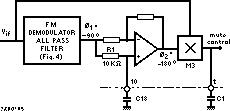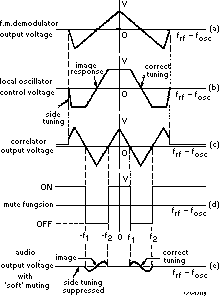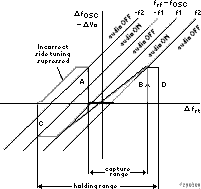TDA7000 - A Complete FM Radio on a Chip
Page 5 of 11
to detuning to the flanks of the demodulator S-curve. Since
the mute threshold is much lower than that obtained with m6st other currently
used muting systems, this muting system is ideal for portable radios which
must often receive signals with a level only slightly above the input noise.

Fig8 Correlator of the TDA7000
As shown in Fig.8, the correlation muting circuit consists
of all-pass filter AP2 connected in series with fm. demodulator all-pass
filter API and adjusted by an external capacitor to provide a total phase
shift of 180*. The output from AP2 is applied to mixer M3 which determines
the correlation between the undelayed limited i.f. signal at one of its
inputs and the delayed and inverted version of it at its other input.The
output from mixer M3 controls a muting circuit which feeds the demodulated
audio signal to the output when the correlation is high, or feeds the
output from a noise source to the output to give an audible indication
of incorrect tuning when the correlation is low. The switching of the
muting circuit is progressive (soft muting) to prevent the generation
of annoying audio transients. The output ftom mixer M3 is available externally
at pin l and can also be used to drive a detuning indicator.
Figure 9 shows that there are two regions where the di. modulated audio
signal is fed to the output because the muting is inactive. 'One region
is centred on the correct tuning point fL. The other is centred on the
image frequency -fL. The image response is therefore not suppressed by
the muting system when the frequency-locked loop is open. When the loop
is closed, the time-constant of the muting system, which is determined
by external capacitor Cl, prevents the image response being passed to
the audio output. This is described under the next heading.

Fig.9 Operation of the correlation muting system with open
loop FLL
Correlation muting system with closed FLL The closed-loop response of the FLL ' is shown in Fig.
l 0, in which the point of origin is the nominal i.f. (frf - fosc = fL.
With correct tuning, the muting is inactive and the audio
Fig.10 Closed-loop response of the FLL. The slops
of the correct tuning 1ine is such that a 75kHz deviation of frf
causes a I5kHz deviation of frf-fosc
